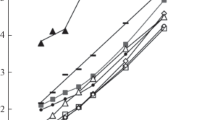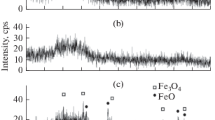Abstract
The pyrometallurgical production of germanium concentrates from the raw materials (coal, argillite, siltstone) of brown coal fields is accompanied by the formation of molten silicate slags. The mineral component of the raw materials concentrates in slags, reaching 60 wt %. It is obvious that the process indices are mainly determined by the physicochemical properties of the molten slags, such as density ρ and surface tension σ, reflecting the structure of molten silicates. The compositions of the slags after processing of carbonaceous raw materials differ significantly from those of the slags of nonferrous and ferrous metallurgy: they contain higher contents of SiO2 (up to 50–55%), Al2O3 (up to 20–22%), K2O, and Na2O (up to 5–6%). In addition, the slags contain significant contents of sulfide sulfur (up to 3%) and trace amounts of nonferrous metals and rare elements (up to 5%). The differences between the compositions of the molten slags of germanium production and the slags of main metallurgy influence their properties and require special studies. Industrial cyclone melting and electric smelting slag samples are studied. Semi-synthetic samples are analyzed; these samples are produced from industrial ones by the addition of SiO2 and CaO in order to determine the influence of composition on ρ and σ. The measurements are based on the maximum pressure in an inert gas bubble blown in a melt, more specifically, on the differential version to improve the accuracy. The cell consists of the melt to be studied in an alundum crucible with an immersed alundum capillary and a reference capillary immersed into distilled water. The melt temperature is measured in the range 1100–1400°C. ρ and σ of the melts are found to fall in the ranges from 2.20 to 4.3 t/m3 and from 218 to 531 mN/m, respectively. The values of ρ and σ significantly depend on the basicity (ratio of the sum of the CaO and MgO contents to SiO2) and the Al2O3 content. The temperature dependences of ρ and σ are found to be linear with negative temperature coefficients. In the general case, ρ and σ of the melts significantly differ from, for instance, the blast furnace slags at the same basicity. The obtained results are valuable for predicting the structures of melts and their behavior under real conditions.



Similar content being viewed by others
REFERENCES
M. Ya. Shpirt, Physicochemical and Technological Principles of the Production of Germanium Compounds (Izd. Kol’skogo Nauch. Tsentra RAN, Apatity, 2006).
I. N. Tanutrov and M. N. Sviridova, “Scientific substantiation, development and implementation of pyrometallurgical technology for the production of germanium concentrates,” Tsvetn. Met., No. 2, 71–75 (2014).
I. N. Tanutrov, V. M. Trofimov, and O. I. Podkopaev, “Complex processing of germanium containing coals to produce concentrates, thermal and electric energy,” in Proceedings of the 2nd International Symposium on Integrated Use of Ores (St. Petersburg, 1996), pp. 239–242.
S. V. Minosyants, N. D. Saenko, and S. S. Minosyants, “Energy engineering design for production of germanium concentrate,” Tsvetn. Met., No. 5, 41–43 (2014).
I. N. Tanutrov and M. N. Sviridova, “Studying the properties of germanium containing coals and carbonaceous rocks,” in Complex Use of Mineral Materials (Vyssh. Shkola Kazakhstana, Almaty, 2017), No. 3, pp. 21–25.
I. N. Tanutrov, M. N. Sviridova, S. O. Potapov, and S.A. Lyamkin, “Heat treatment of germanium-containing carbon raw materials,” Butlerovskiye Soobshcheniya 49 (2), 117–121 (2017).
I. N. Tanutrov, Yu. A. Tsabolov, A. D. Vershinin, and A. M. Plitanov, “Physicochemical properties of CaO–Al2O3–SiO2–CaS melts doped with alkali metal oxides,” in Transactiona of the Institute of Metallurgy, USSR Academy of Sciences (1977), No. 30, pp. 108–133.
B. V. Linchevsky, Technique of Metallurgical Experiment (Metallurgiya, Moscow, 1967).
I. N. Tanutrov, V. P. Kostenetsky, G. I. Leontiev, and A. I. Okunev, “A differential method for measuring the density and surface tension of melts,” Zavod. Lab., No. 12, 1473–1475 (1970).
B. P. Yuriev, “Studying the thermophysical properties of blast furnace slags during their heat treatment,” Izv. Vyssh. Uchebn. Zaved., Chern. Metall., No. 11, 5–10 (2014).
E. V., Dyuldina and Yu.V. Kocherzhinskaya, “Physicochemistry of blast furnace slag,” Izv. Chelyabinskogo NTs 4 (21), 96–104 (2003).
I. N. Andronov, B. V. Chakin, and S. V. Nesterenko, Liquid Metals and Slags (Metallurgiya, Moscow, 1977).
Funding
This work was supported by project no. 18-5-5-42 of the Program of the Ural Branch of the Russian Academy of Sciences for 2018–2020 (Fundamental Problems of the Earth Sciences and the Development of Mining Complex).
Author information
Authors and Affiliations
Corresponding author
Additional information
Translated by I. Moshkin
Rights and permissions
About this article
Cite this article
Tanutrov, I.N., Lyamkin, S.A. & Sviridova, M.N. Density and Surface Tension of the Molten Slags of Germanium Concentrate Production. Russ. Metall. 2021, 234–238 (2021). https://doi.org/10.1134/S0036029521020282
Received:
Revised:
Accepted:
Published:
Issue Date:
DOI: https://doi.org/10.1134/S0036029521020282




